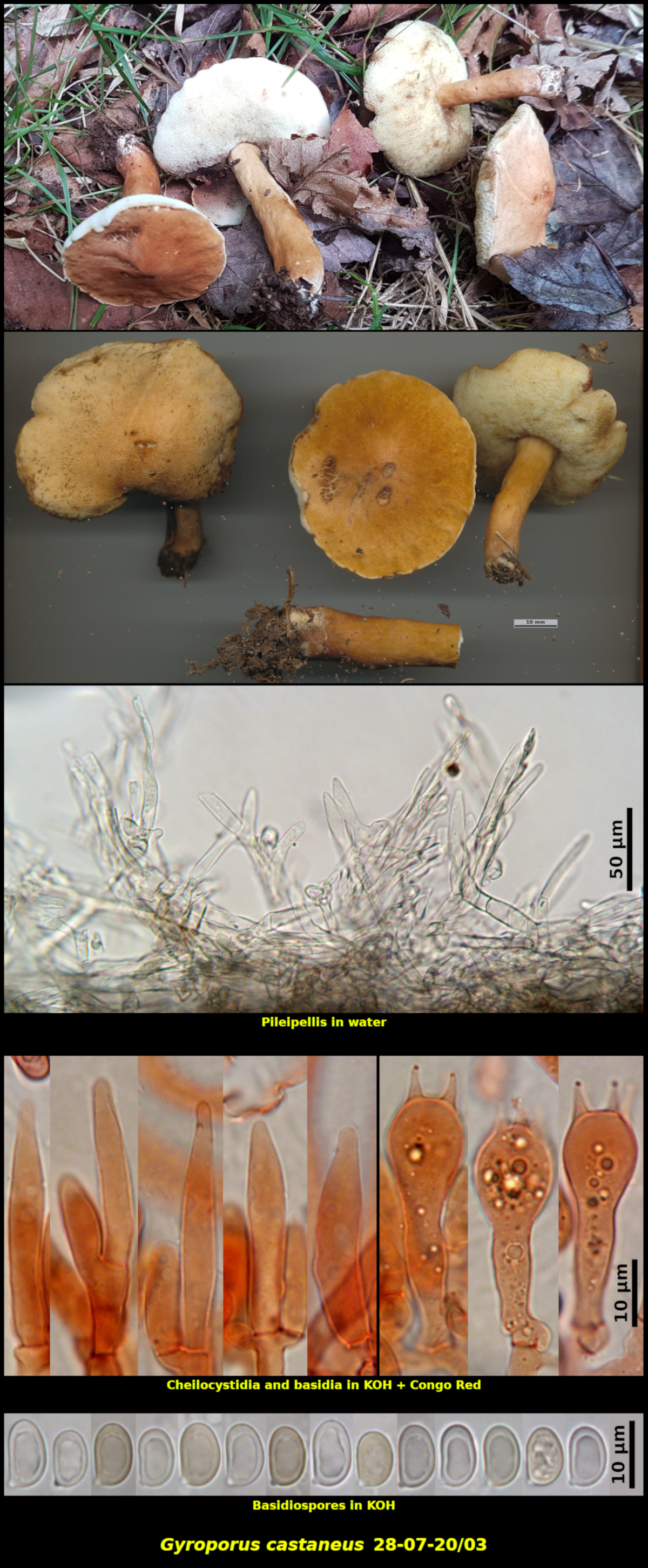Fleshy Fungi of New Brunswick >>
Gyroporus castaneus
Gyroporus castaneus (Bull.) QuÉl.

Gregarious in grassy disturbed area near a brook, associated with Betula alleghaniensis – Wilson Brook Protected Natural Area, New Brunswick (28-07-20/03).
Pileus broadly convex, with a low umbo, light yellow orange (HSV30:50-60:90), fading to a paler shade (HSV35:20:100) although maintaining darker colours on the umbo, with a matte suede-like surface texture, dry, 43-55 mm in diameter (a larger overmature basidioma was seen in the field but not collected). Stipe equal to narrowly clavate, similar in colour and texture to the pileus, without vestiges of a veil, glabrous throughout, 30-66 x 7-13 mm. Tubes very pale yellow to nearly white at first, later yellow (HSV50:10-20:100), with some brown stains where bruised, adnexed, about 1.7/mm. Flesh white at first, becoming yellow (HSV50:20:100) in age, with a nondescript mushroom odour and taste.
Basidiospores producing a thin print insufficent for colour recording, microscopically nearly hyaline to light brown, ellipsoidal, smooth, with wall appearing thick in KOH mounts, 7.2-10.6 x 4.8-6.4 μm, Q =1.51-1.84 (average[52]: 9.1 x 5.4 μm, Q = 1.67). Cheilocystidia abundant, lanceolate to narrowly ventricose, 22-45 x 4.0-7.6 μm, occasionally as longer seta-like elements with slightly thickened walls. Basidia 4-spored, with a basal clamp connection. Pileipellis a trichodermium, with terminal cells of the hyphae resembling the cheilocystidia or swollen and brown. Stipitipellis similar to the pileipellis.
Although G. castaneus is considered to be a common fungus in eastern North America, it's Canadian distribution is clearly southern. Maps generated by iNaturalist and Mycoportal show its eastern Canadian distibution to be in southern Nova Scotia and along the Great Lakes/St. Lawrence River/Ottawa River regions. Collection 28-07-20/03 is the first vouchered record for New Brunswick. It has been reported from Fundy National Park (Mushroom Observer Observation 50937) and from McLeods, E. of Cambellton (iNaturalist observation 50521859) but neither with herbarium vouchers. Michel Kuo, on his MushroomExpert.Com Web site, cites collections he has made of this species having significantly smaller basidiospores, which suggests that more than one species may be hiding under the name G. castaneus. This also underlines the importance of keeping vouchers rather than just trusting field identifications.
Gyroporus castaneus might easily be mistaken for a species of Boletus. The brown colour of the cap and stipe are common enough in that genus although the nearly white pores are noteworthy. Microscopically the broadly rounded basidiospores are quite unusual for a bolete. Nearly all of our boletes have the typical greatly elongated and narrow "boletoid" basidiospores, quite unlike those of G. castaneus.
Photograph: D. Malloch (28-07-20/03).